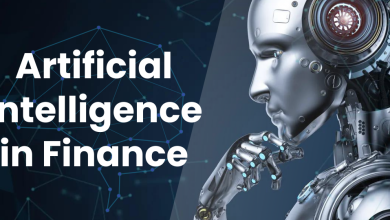
AI and Blockchain: Building Tomorrow’s Market Infrastructure
The next wave of financial innovation isn’t about crypto or AI alone. It’s the convergence of these technologies into a new market infrastructure where digital assets serve as programmable capital, and artificial intelligence operates as the logic governing everything from trading to treasury management. Behind tokenized funds, on-chain treasuries, and validator-node networks are AI systems managing data, risk, and execution at machine speed. As capital accelerates, we face a defining challenge: designing intelligence that serves humanity, not just markets.
Every industrial revolution has been powered by infrastructure: railroads, power grids, the internet. The next one, driven by AI, digital assets, and decentralized energy, will require a more complex foundation. It won’t be purely technological. It will demand new financial and governance systems built for transparency, adaptability, and long-term coherence.
This evolution is already underway. AI, digital assets, clean energy, validator-node infrastructure, DePIN, autonomous defense, and longevity are no longer isolated verticals. They’re converging faster than most institutions are prepared for. But capital systems remain fragmented, optimized for short-term velocity over long-term alignment.
What’s needed now is a shift in how we think about capital architecture. Legal, structural, and operational frameworks must evolve to ensure emerging technologies scale responsibly, aligned not just with market incentives but also with environmental and social realities.
Institutional momentum is already moving in this direction. BlackRock’s BUIDL fund tokenizes U.S. Treasuries, bringing traditional capital markets onto programmable, transparent rails. JPMorgan’s Tokenized Collateral Network enables real-time collateral transfers using blockchain infrastructure. Orthogonal’s Capital Infrastructure Group and LIF3 ecosystem apply similar principles, combining decentralization, governance, and regenerative design into a new model of financial infrastructure.
Investor’s Dilemma: Balancing Speed with Transparency
AI valuation complexity highlights core governance challenges including model drift, oracle risk, and unclear intent in algorithmic finance. Financial tools like structured equity, venture debt, and token presales can misrepresent true market fit, while modern finance increasingly relies on algorithmic pattern recognition rather than clear purpose. As algorithms execute faster, larger decisions, transparency and intent become critical to avoid worsening inequality and speculative bubbles.
A key solution is validator governance, adapted from decentralized blockchain networks. This model assigns independent nodes to verify data, decisions, and transactions in real time, ensuring accountability. Outcomes become auditable, oversight is embedded, and energy use is trackable. This approach moves capital away from speculation toward more stable, reality-aligned results.
Conscious Capital: Governance for the Era of Intelligent Systems
Orthogonal’s Capital Infrastructure Group emerged from recognizing that markets consistently underestimate the speed and scale of AI and infrastructure convergence. Rather than pursuing speculative AI multiples, the focus is on building frameworks for sustainable value through alliances, vehicles, and validator networks that integrate capital formation with ethical execution.
Transparency means verifiable data, on-chain accountability, and immutable records that reduce information gaps. Model accountability requires version control, oversight, and human-in-the-loop safeguards to prevent errors or unintended consequences. Energy realism refers to aligning AI development with sustainable power sources and environmental constraints. Programmable compliance embeds ethical and legal guardrails directly into smart contracts, enabling automated enforcement and adaptability as regulations evolve. Innovation must be grounded locally, connected to communities and feedback systems that maintain human alignment on a global scale.
This is conscious capital: capital extending beyond profit to resilience, regeneration, and accountability, serving as a governance framework for intelligent systems.
A Playbook for Investing in AI and Tokenized Finance
For investors entering AI and tokenized finance with clarity and impact, governance must be treated as infrastructure. Validator systems mirroring decentralized trust models create transparency and accountability. Tokenization should enforce transparency, not just liquidity.
Bridging wellness and finance is key. Capital should flow where health data and human outcomes are directly linked, supporting regenerative economic cycles. Energy coherence means ensuring AI systems are powered by traceable, renewable energy aligned with sustainability goals. Capital frameworks should be adaptable, evolving alongside technological convergence.
Model accountability requires oversight, version control, and human-in-the-loop mechanisms to manage risk and maintain alignment. Compliance should be programmable, embedding ethics and law directly into capital logic. Finally, innovation must be grounded in local ecosystems to ensure feedback loops that preserve human-centric outcomes.
Orthogonal’s Model: Decentralization Meets Regeneration
Orthogonal provides a practical example of integrating AI, blockchain, and finance. Its AI-driven LIF3 ecosystem scales validator-node infrastructure that offers real-time data verification, ensuring transparency and accountability in digital asset operations. This model connects computation, energy use, and human well-being—key considerations for sustainable AI governance.
In parallel, Orthogonal is launching a tokenized hedge fund focused on validator-node infrastructure and governance-aligned investment strategies. This fund exemplifies a new generation of financial products built for transparency and regulatory compliance. These examples illustrate how decentralized, accountable systems can be operationalized to support responsible AI and digital asset scaling.
Guiding the Future: Intelligence Governed for Life and Sustainability
If the last century rewarded speed and scale, the next will reward alignment, with systems that maintain coherence under pressure. AI valuation must move beyond compute capacity or market sentiment to consider energy balance, measuring how efficiently a system converts inputs into meaningful, human-centered outcomes.
Conscious capital reframes value as multidimensional—financial, ethical, and energetic. The next industrial revolution is not about machines alone but about how governance frameworks shape their impact.
As capital accelerates and AI grows more autonomous, the central question shifts from what these systems can do to what they should do and how to guide them responsibly. The future depends on designing intelligence accountable to life itself, ensuring that capital is aligned with human values and sustainable outcomes.
David Nikzad is a serial entrepreneur, investor, and founder of Orthogonal Thinker Inc., pioneering plant medicine, AI-driven wellness, and regenerative living. He has backed ventures like Airbnb and Axiom Space and is now leading an initiative to build an AI-powered regenerative campus in Hawai ‘ i, uniting finance, technology, and nature to advance human potential.




